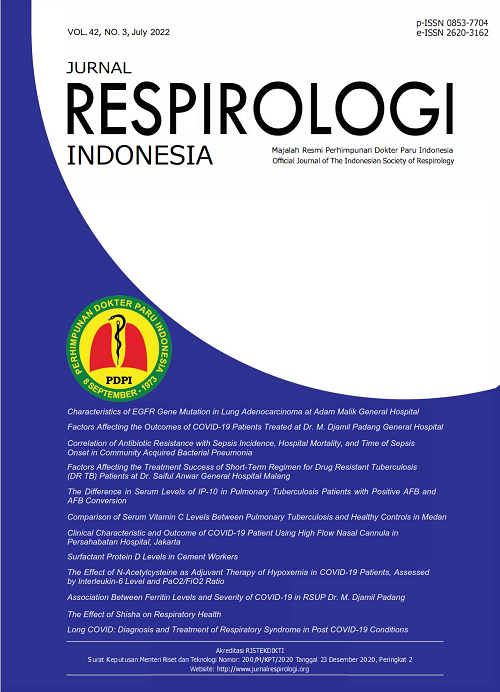Correlation of Antibiotic Resistance with Sepsis Incidence, Hospital Mortality, and Time of Sepsis Onset in Community Acquired Bacterial Pneumonia
DOI:
https://doi.org/10.36497/jri.v40i3.359Keywords:
Hospital mortality, MDRO, Sepsis, Time of sepsis onsetAbstract
Background: Community acquired pneumonia is associated with high morbidity and mortality. Treatment of multidrug-resistant organisms (MDRO) infection in pneumonia is a challenge. Antibiotic resistance is a major factor determining clinical treatment unresponsiveness and rapid progression to sepsis. Septic patients with MDRO have a higher hospital mortality. The correlation of antibiotic resistance with the incidence of sepsis and hospital mortality is yet to be known. This study analyzed the correlation of antibiotic resistance with sepsis incidence, hospital mortality, and time of sepsis onset.
Methods: Retrospective cohort study of patients with community acquired bacterial pneumonia from July-December 2019 at RSUD Dr. Moewardi. The correlation between antibiotic resistance and incidence of sepsis, hospital mortality was tested by using Chi Square and Fisher's exact test correction. Association between two variables with relative risk. Survival analysis and log rank test were used to examine the time differences of sepsis onset.
Results: There was a correlation between antibiotic resistance and incidence of sepsis in community acquired bacterial pneumonia (r = 0.417, p = 0.000) with RR = 4,294 (95% CI 2,886-6,390). The median time of sepsis onset was day 0 in the MDRO group and day 4 in non-MDRO group (p = 0.000).
Conclusion: There is a correlation between antibiotic resistance and incidence of sepsis in community acquired bacterial pneumonia with a fairly strong and significant correlation value. The presence of antibiotic resistance increases the incidence of sepsis fourfold. Antibiotic resistance also affects the time of sepsis onset.
Downloads
References
Dafitri IA, Khairsyaf O, Medison I, Sabri YS. Korelasi qSOFA dan NLR terhadap kadar prokalsitonin untuk memprediksi luaran pasien sepsis pneumonia di RSUP dr. M. Djamil Padang. J Respir Indo. 2020;40(3):173–6.
Uranga A, Restrepo M, Chalmers J, Blasi F, Aliberti S. Drug-resistant pathogens in community-acquired pneumonia. Community Acquir Infect. 2015;2:123–30.
Luan Y, Sun Y, Duan S, Zhao P, Bao Z. Pathogenic bacterial profile and drug resistance analysis of community-acquired pneumonia in older outpatients with fever. J Int Med Res. 2018;46(11):4596–604.
Perhimpunan Dokter Paru Indonesia. Pneumonia Komunitas. Pedoman diagnosis dan penatalaksanaan di Indonesia. 2nd ed. 2014;1–52.
Cillóniz C, Dominedò C, Torres A. Multidrug resistant gram-negative bacteria in community-acquired pneumonia. Crit Care. 2019;23(1):79.
Gotts JE, Matthay MA. Sepsis: pathophysiology and clinical management. BMJ. 2016;353:i1585.
Zilberberg MD, Shorr AF, Micek ST, Vazquez-Guillamet C, Kollef MH. Multi-drug resistance, inappropriate initial antibiotic therapy and mortality in Gram-negative severe sepsis and septic shock: a retrospective cohort study. Crit Care. 2014;18(6):596.
Torres A, Cillóniz C, Ferrer M, Gabarrús A, Polverino E, Villegas S, et al. Bacteraemia and antibiotic-resistant pathogens in community acquired pneumonia: risk and prognosis. Eur Respir J. 2015;45(5):1353–63.
Prina E, Ranzani OT, Polverino E, Cillóniz C, Ferrer M, Fernandez L, et al. Risk factors associated with potentially antibiotic-resistant pathogens in community-acquired pneumonia. Ann Am Thorac Soc. 2015;12(2):153–60.
Capsoni N, Bellone P, Aliberti S, Sotgiu G, Pavanello D, Visintin B, et al. Prevalence, risk factors and outcomes of patients coming from the community with sepsis due to multidrug resistant bacteria. Multidiscip Respir Med. 2019;14:23.
Firmansyah MA, Amin Z, Loho T, Shatri H. Faktor-faktor prediktor mortalitas community-acquired pneumonia dalam perawatan inap di rumah sakit cipto mangunkusumo, jakarta. Indones J Chest Crit Emerg Med. 2015;2(2):45–53.
Zilberberg MD, Nathanson BH, Sulham K, Fan W, Shorr AF. Multidrug resistance, inappropriate empiric therapy, and hospital mortality in Acinetobacter baumannii pneumonia and sepsis. Crit Care. 2016;20(1):221.
Busani S, Serafini G, Mantovani E, Venturelli C, Giannella M, Viale P, et al. Mortality in Patients With Septic Shock by Multidrug Resistant Bacteria: Risk Factors and Impact of Sepsis Treatments. J Intensive Care Med. 2019;34(1):48–54.
Downloads
Additional Files
Published
Issue
Section
License
- The authors own the copyright of published articles. Nevertheless, Jurnal Respirologi Indonesia has the first-to-publish license for the publication material.
- Jurnal Respirologi Indonesia has the right to archive, change the format and republish published articles by presenting the authors’ names.
- Articles are published electronically for open access and online for educational, research, and archiving purposes. Jurnal Respirologi Indonesia is not responsible for any copyright issues that might emerge from using any article except for the previous three purposes.
















